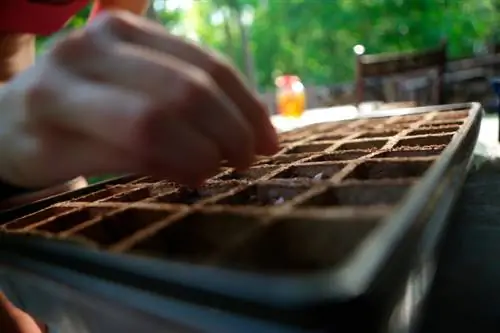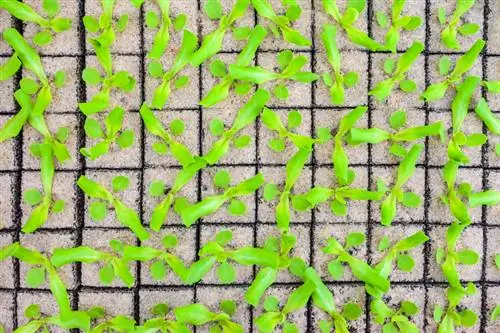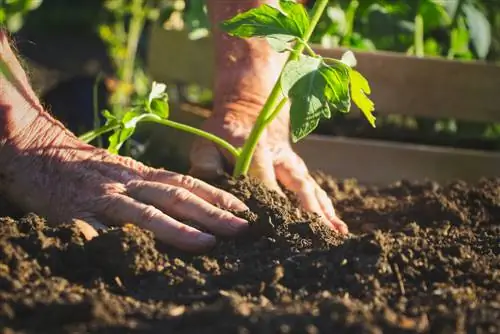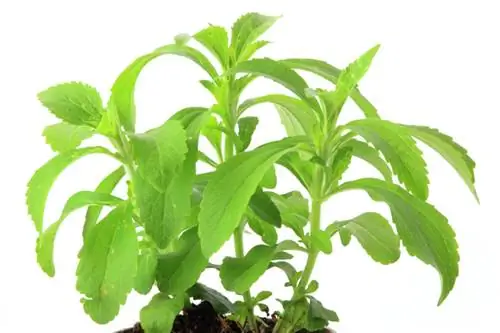- Author admin [email protected].
- Public 2023-12-16 16:46.
- Last modified 2025-06-01 06:02.
While your tomato seedlings are being grown until mid-May after the Ice Saints, you can already get active in the garden. You can find out in this article what measures caring for tomato plants involves and how to start in spring.
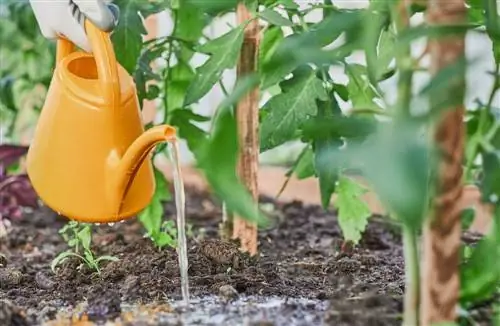
How do you properly care for tomato plants?
Caring for tomato plants includes regular fertilizing, watering, cutting and providing climbing aids. Fertilization varies depending on location, while consistent watering is essential. Shoots should be pinched out to prevent dense growth.
How to care for tomato plants?
Tomato care consists of fertilizing, watering and cutting. Fertilize potted tomatoes weekly with organic liquid fertilizer. In the greenhouse and bed, one dose every two weeks is sufficient. Compost or horn shavings can also be used here. Adapt your watering behavior to the weather conditions and water regularly. If the tomato plant is too dense, shoots should be pinched out or removed completely.
The four most important care measures
Tomato care is not a science. If you just take the four most important measures to heart, then garden beginners will be able to collect their first aromatic tomatoes this summer. Trellises and pinching ensure upright and fruit-bearing growth. Watering and fertilizing require regularity and the right amount, but you quickly get the feel for it.
Trails
So that the tomato plant does not grow just above the ground or collapse under the weight of its own fruit, trellises are irreplaceable from cultivation to harvest. Unlike the wild vine, which climbs itself up walls and fences, tomatoes need a little help getting started.
There is a suitable climbing aid for every variety. The price, the effort (do-it-yourself) and the longevity are other factors that influence the selection of the right aids. Four classic trellises that have proven to be stable and effective are presented below.
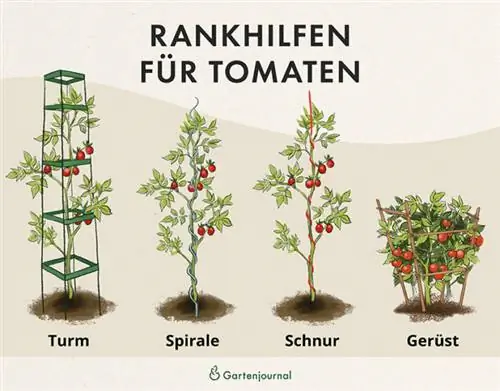
Tomato Tower: The light plastic towers, obelisks and pyramids provide the safest support due to their stable construction. Tomato towers are suitable for outdoor and container tomatoes that grow over one meter in height.
Tomato spiral: The tomato spirals are more massive and slightly more expensive and prove to be particularly effective for stick tomatoes in the field. Mostly made of stainless steel, the winding trellises will be used for years to come.
Tomato string: With the tomato string you can grow stick tomatoes cost-effectively and sustainably. However, the place of use is limited, because in order to let the tomato plants grow skyward on a string, a roof or a crossbar above the plants is necessary - ideal for the greenhouse.
Tomato scaffold: In order to give tomato plants such as the bushy wild tomato as much space as possible across the width, it is recommended to use a tomato scaffold. Funnel or sun-shaped frameworks enable stable growth in all directions.
Simply
Many classic tomato varieties are bred so that they grow very quickly and constantly form new shoots. In order to specifically promote the development of the red fruits, so-called stingy shoots should be removed regularly after planting the young tomato plants. These only form leaves and deprive the plant of important nutrients without bearing fruit themselves.
Avaricious shoots grow from the armpits between the trunk and the growth shoots. The stingy shoots can be easily removed with your fingernails or a knife. From June onwards, the plant should be checked from bottom to top about once a week for these tugging shoots.
Read how to properly prune your tomato plants.

Pouring
Tomato plants love the sun and are therefore very thirsty. A continuous water supply is therefore essential. As with all things in life, the following applies here: the right amount. Too much water (especially in the pot) can lead to waterlogging and too little moisture causes the plant to dry out. Tomatoes generally need to be watered every day and ideally always at the same time.
Basically, we recommend watering with a gentle jet or a watering spray that moistens the soil as close to the ground as possible. The leaves of the tomato are extremely sensitive to moisture and splashing earth, which can potentially lead to diseases. You can find special utensils in specialist shops so that watering is successful even for beginners.

Clay pot with a hole in the bottom: To water tomatoes inexpensively and without splashing water, small clay pots with a diameter of approx. 12 cm can be buried next to the tomato plant. The plant is watered through this. The roots grow in the direction of the clay pot. The method is very suitable for tubs and pots.
Watering ring: Watering rings (10-20 euros) are constructed in such a way that the plant in the middle is surrounded by a moat like a castle. The advantage is that you can always keep an eye on the water level and simply refill it. At the same time, the special construction keeps snails and other predators away.
Olla: Ollas (30-50 euros) are placed in the ground in the immediate vicinity of the tomato plants so that only the neck shows out. The water is then added to the vessel. From there, the liquid seeps further into the earth when the soil becomes dry. Olles are available in different sizes. The more water an Olla can hold, the longer and the more plants in the area can be watered.
Fertilize
Tomato plants are heavy feeders. This means that they extractan above-average amount of nutrients or minerals from the soil. Modern breeds in particular can hardly survive without replenishment of nutrients. That's why tomatoes should be regularly supplied with appropriate fertilizer. The location and the variety should be taken into account.
The important minerals nitrogen, phosphate, potassium, calcium and sulfur are added to the soil using organic fertilizers such as manure, horse manure or horn shavings. Inorganic fertilizers such as blue grain should be used carefully and in moderation as they can also lead to harmful oversupply. You can find out more about correct fertilization here.
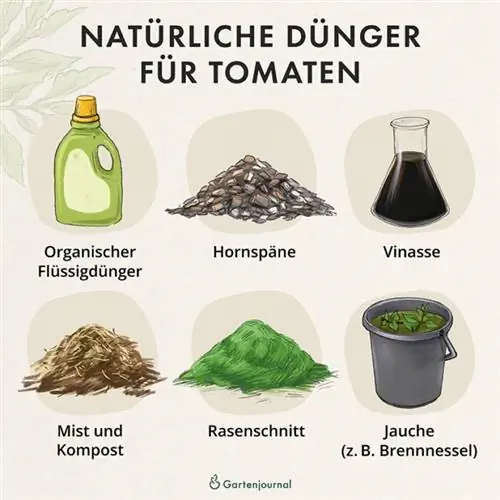
Successful harvest the following year
Anyone who has grown tomatoes in their garden will want to continue the enjoyment next year. With the right location and a good neighborhood, you can always create a place for the plant to feel comfortable. Green manure after the harvest season helps the soil get fit again for the following summer.
The choice of location
Tomatoes are very picky when it comes to their location. For a productive harvest, awarm, sunny place should be chosen. The south wall or the south balcony, for example, provide the necessary six to seven hours of sun and also protect against wind and rain. The latter is anathema to tomatoes and often leads to disease if left unprotected.
The greenhouse provides the best growing conditions for the reasons mentioned. But tomatoes also grow happily outdoors in containers and beds if they are cared for appropriately. You should pay attention to nutrient-rich soil and a pH value of 6-7. A well-plowed, loose soil is also recommended.
| Greenhouse | Freeland | Pot | |
|---|---|---|---|
| Time | Early to mid-May | Mid-May to Ice Saints | Mid-May to Ice Saints |
| Distance | 60cm | 60cm | one plant per pot |
| Planting depth | Slightly deeper (5-8 cm) than in the nursery pot | Deeper (8-15 cm) than in the nursery pot | Stem base should be well covered |
Neighbors
Good neighbors bring joy - even for tomatoes. The targeted cultivation of plants that are compatible with each other is a proven tradition in agriculture. A colorful greenhouse, bed or even a large container with several species not only looks prettier but also brings effective benefits.
On the one hand, the additional plants protect the soil from direct sunlight, which counteracts drying out. On the other hand, the right neighbors protect against diseases, snails, etc. Good neighbors are usually weak eaters in order to prevent an undersupply of minerals.
Good neighbors: Good neighbors include lettuce, garden cress, basil, chamomile and parsley. Onions and garlic also get along well with tomatoes. Carrots also loosen the soil due to their long roots and marigolds attract bees, repel pests and add color to the bed.
Bad neighbors: Potatoes transmit the dreaded brown rot to tomatoes and should therefore be as far away as possible. Other bad neighbors are generally heavy eaters like cabbage; But you shouldn't plant peas, fennel and cucumbers in the immediate vicinity either.
FAQ
How big do tomato plants get?
The size of tomato plants depends primarily on the variety. Bush tomatoes grow up to 50 cm high, the balcony starling reaches around 60 cm. Stick tomatoes, on the other hand, can grow to be over two meters tall and wild tomatoes can sometimes grow to a meter wide.
Why do my tomatoes have lots of leaves but no fruit?
The fact that tomato plants produce many leaves but no fruits can be attributed to various reasons. Incorrect cultivation can cause lasting damage to the plant. More likely, however, is the wrong location or too many miserliness. Both inhibit the energy for fruit formation.
Why do tomatoes burst on the vine?
Bursting tomatoes can usually be traced back to too much water at a low ambient temperature. The plant absorbs more water than it can evaporate. On the other hand, too much sun exposure can also cause the skin to crack. Regular watering in the morning or evening and sun protection when it is too hot can help.
When can I harvest tomatoes?
Most varieties ripen in August to early September. The most striking characteristic “red” is only partially a sufficient factor for the best harvest time. A pressure test should be crucial: ripe tomatoes give way. The pressure test is more precise than the eye, even for yellow, green and black tomatoes.
Can tomatoes be planted in the same place every year?
Basically yes; if the soil has been supplied with sufficient nutrients during tomato cultivation and is not depleted. It is advisable to give the soil some recovery after the harvest season with green manure. As a result, minerals accumulate and the soil is loosened.


